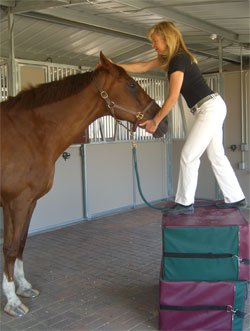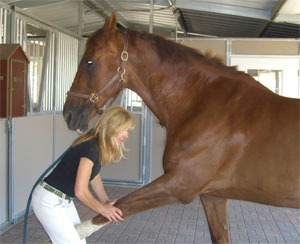Chiropractic Care for Horses
HOW OFTEN WILL MY HORSE
NEED TO BE ADJUSTED? 
The protocol for each horse will be determined individually based on the findings of the veterinary chiropractic exam, the discipline of the horse and the horse’s training regime.
In most cases, a single treatment is not enough to eliminate the problem. The goal of veterinary chiropractic treatment is to address neurological dysfunction in the spine and restore mobility. It is then the task of muscles and ligaments to support the spine and maintain the restored motion of the spinal joints.
Most horses will show significant improvement after one to four treatments. Chronic problems usually take longer to resolve requiring more chiropractic adjustments, while horses with acute problems often respond more quickly. Once the horse has achieved significant improvement, a supportive care schedule will be established if needed. Most horses that are competing regularly do well on a consistent schedule of monthly adjustments. In this way, restrictions to mobility that may develop are addressed regularly and frequently prior to the rider ever feeling a problem. The goal is to help the horse to stay in optimum comfort and prevent a problem from becoming established.
WHAT CAN CAUSE DAMAGE TO THE SPINE?
• Trauma - falls, trips, cast in stall
• Narcotics - general anesthesia
• Transportation
• Lack of adequate room to move - long periods in stall with no opportunity to ease tension by bucking and rolling
• Performance – every event strains the spine in a different specific way
• Rider – problems with the rider’s seat (crooked seat)
• Shoes – poor hoof care or incorrect shoeing
• Poor saddle fit
• Birthing Difficulties
• Age – as age increases the effects of previous small and/or large traumas to the spine become more apparent
• Activities of everyday living (repetitive trauma over time)
WHAT ARE THE SYMPTOMS THAT INDICATE MY HORSE MAY BENEFIT FROM CHIROPRACTIC CARE?
• Back Pain
• Neck Pain 
• Reduced Performance
• Abnormal Posture
• Snapping and pinning ears
when being saddled
• Resistance to aids when being ridden
• Head throwing, back hollowing
• Disobedience when jumping
• Difficulties with collected or lateral gaits
• Changes in behavior
• Frightened or painful facial expression
• Sensitivity to touch
• Muscle atrophy
• Difficulty flexing the poll
• Stiffness when starting to work
• Difficulty bending
• Difficulty with lead changes
In addition to the above symptoms, veterinary chiropractic care may be useful in the following disease conditions by correcting biomechanical abnormalities of the spine or extremities:
• After anesthesia (for MRI or surgical procedure)
• Post operatively
• Navicular Syndrome
• Upward fixation of the patella (locking stifles)
• Stringhalt
• Arthritis
HOW CAN CHIROPRACTIC CARE HELP A HORSE WITH NAVICULAR DISEASE?
Chiropractic care has the potential to help the horse with navicular disease by changing the biomechanics of the way the horse stands. For example, if a horse stands with his front legs too far underneath his body, this puts additional strain on the deep flexor tendon. The deep flexor tendon attaches to the back of the coffin bone and runs over the back of the navicular bone. If there is strain on the deep flexor tendon, this effectively jams the navicular bone into the back of the coffin bone and the 2nd phalanx with the result of there being additional pressure on the navicular bone. This can lead to degeneration of the navicular bone. By adjusting the horse, it is possible to correct the abnormal stance and thereby relieve the strain on the deep digital flexor and thereby the pressure on the navicular bone.
Chiropractic Care for Pets